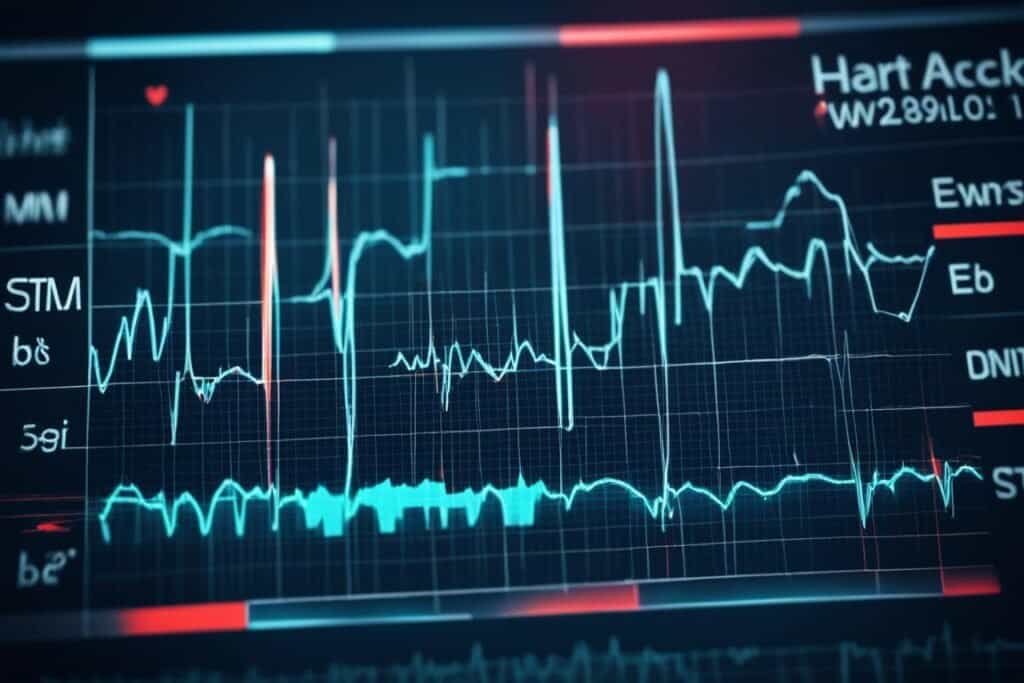During a heart attack, it’s natural to wonder about your heart rate and what it means. Does a high heart rate indicate a more severe heart attack? Is a low heart rate a cause for concern? In this article, we’ll tackle these questions and more to help you better understand the relationship between heart rate and heart attacks.
Key Takeaways:
- A high heart rate is not a reliable sign or symptom of a heart attack.
- Heart rate can vary during a heart attack based on various factors like overall health, medications, and the type of heart attack.
- Different types of heart attacks can affect heart rate differently.
- Blood pressure may also fluctuate during a heart attack.
- Recognizing the symptoms of a heart attack is crucial for seeking timely medical attention.
How a Heart Attack Affects Heart Rate
During a heart attack, the heart muscles receive less blood flow, leading to a reduction in oxygen supply. This can cause damage to the heart muscle cells and affect heart rate. The extent of the damage and its impact on heart rate can vary depending on factors such as the severity and duration of the blockage or restriction in blood flow, the location of the affected area, and individual differences. While some individuals may experience an increase in heart rate during a heart attack, others may not. It’s important to note that a rapid heart rate is just one of many possible symptoms of a heart attack and should not be relied upon as the sole indicator. Other common symptoms of a heart attack include chest pain, shortness of breath, nausea, and sweating.
Different Types of Heart Attacks and their Effects on Heart Rate
There are three types of heart attacks that can affect heart rate in different ways:
- ST-segment elevation myocardial infarction (STEMI)
- Non-ST segment elevation myocardial infarction (NSTEMI)
- Coronary artery spasm
STEMI heart attacks, which involve a complete blockage of a coronary artery, typically cause an elevated heart rate. However, certain types of STEMI can result in damage to the heart’s electrical system and slow down the heart rate. NSTEMI heart attacks, which involve a partial blockage of an artery, can also increase heart rate.
Note: The heart rate during a heart attack can also be influenced by factors such as medication use, including beta-blockers, which can slow the heart rate.
Coronary artery spasms, another type of heart attack, can affect heart rate by restricting blood flow to the heart. It’s essential to understand that heart rate alone is not sufficient for diagnosing a heart attack, and other symptoms and medical evaluations are necessary.

*Table: Comparison of Heart Rate Effects in Different Types of Heart Attacks*
| Heart Attack Type | Effect on Heart Rate |
|————————————————|——————————|
| ST-segment elevation myocardial infarction (STEMI) | Elevated heart rate |
| Non-ST segment elevation myocardial infarction (NSTEMI) | Increased heart rate |
| Coronary artery spasm | Potentially variable |
Note: The effects on heart rate may vary depending on individual factors and medical conditions.
Recognizing the Symptoms of a Heart Attack
Recognizing the symptoms of a heart attack is crucial for timely intervention. By identifying these signs, you can take immediate action to seek medical help and potentially save a life. Here are the common symptoms associated with a heart attack:
- Chest pain, pressure, or discomfort: A tight and squeezing sensation in the chest is a classic symptom of a heart attack. This pain may radiate to the arms, neck, jaw, back, or stomach.
- Shortness of breath: Difficulty breathing or feeling like you can’t catch your breath can be a sign of a heart attack.
- Lightheadedness: Feeling lightheaded, dizzy, or faint can occur during a heart attack. It’s important not to ignore these symptoms.
- Nausea: An upset stomach or feeling nauseous, sometimes accompanied by vomiting, can be a symptom of a heart attack.
- Cold sweat: Sudden and unexplained cold sweats, similar to breaking out in a cold sweat, can occur during a heart attack.
- Discomfort in various areas: Discomfort or pain that spreads to the arms, neck, jaw, back, or stomach can indicate a heart attack.
It’s important to note that symptoms may vary between individuals and can present differently based on gender. While chest pain or fullness is a typical symptom for both men and women, women are more likely to experience atypical symptoms such as discomfort in areas other than the chest.
If you or someone around you experiences these symptoms, especially if they occur in conjunction with an elevated heart rate, it’s crucial to seek immediate medical attention. Remember, recognizing the signs and acting swiftly can make a significant difference in the outcome of a heart attack.
| Symptom | Description |
|---|---|
| Chest pain, pressure, or discomfort | A tight and squeezing sensation in the chest that may radiate to other areas of the body. |
| Shortness of breath | Difficulty breathing or feeling like you can’t catch your breath. |
| Lightheadedness | Feeling lightheaded, dizzy, or faint. |
| Nausea | An upset stomach or feeling nauseous, sometimes accompanied by vomiting. |
| Cold sweat | Sudden and unexplained cold sweats, similar to breaking out in a cold sweat. |
| Discomfort in various areas | Discomfort or pain that spreads to the arms, neck, jaw, back, or stomach. |
Risk Factors and Prevention of Heart Attacks
Understanding the risk factors for a heart attack is crucial in preventing its occurrence. Several common factors increase the likelihood of experiencing a heart attack. These include:
- Family history of heart disease: If you have close relatives such as parents or siblings who have suffered from heart disease, your risk may be higher.
- Smoking: Cigarette smoking is a major risk factor for heart attacks. Quitting smoking can significantly reduce your risk.
- High blood pressure: Elevated blood pressure puts extra strain on your heart and arteries, increasing the chances of a heart attack.
- High cholesterol: High levels of LDL (bad) cholesterol in your blood can lead to the formation of plaque in your arteries, restricting blood flow to the heart.
- Age: The risk of heart attacks increases with age. Men over the age of 45 and women over the age of 55 are more susceptible.
- Obesity: Being overweight or obese puts additional stress on your heart and can contribute to the development of other risk factors such as high blood pressure and diabetes.
- Diabetes: Individuals with diabetes are at a higher risk of heart disease and heart attacks.
- Sedentary lifestyle: Lack of regular physical activity can lead to obesity, high blood pressure, and other risk factors for heart attacks.
Modifying certain lifestyle behaviors can significantly reduce the risk of a heart attack. Consider the following preventive measures:
- Quit smoking: Seek professional help or employ cessation aids to quit smoking and improve your overall cardiovascular health.
- Maintain a healthy weight: Incorporate a balanced diet, portion control, and regular exercise to achieve and maintain a healthy weight.
- Exercise regularly: Engage in at least 150 minutes of moderate-intensity aerobic activity every week or 75 minutes of vigorous-intensity exercise to strengthen your heart and improve overall fitness.
- Manage high blood pressure: Monitor your blood pressure regularly and follow your healthcare provider’s recommendations for medication, lifestyle changes, and stress management to keep it under control.
- Control cholesterol levels: Eat a heart-healthy diet low in saturated and trans fats and high in fruits, vegetables, whole grains, and lean proteins. If necessary, take prescribed medications to manage cholesterol levels.
- Manage diabetes: Follow your healthcare provider’s guidance for managing your blood sugar levels through diet, exercise, and medication.
- Avoid excessive stress: Incorporate stress-reducing activities such as meditation, mindfulness, or hobbies to manage stress effectively.
In addition to making these lifestyle changes, it’s essential to seek prompt medical attention if you experience any symptoms or indications of a heart attack. Early intervention is vital in preventing further damage to the heart and improving the chances of a successful recovery.

Treatment Options for Heart Attacks
Prompt medical treatment is vital in the event of a heart attack to reduce the risk of complications and minimize heart muscle damage. When you experience a heart attack, the immediate goal is to restore blood flow to the heart as quickly as possible. Treatment options may include:
- Administering aspirin: Aspirin is often given during a heart attack to reduce the size of blood clots and improve blood flow to the heart.
- Using beta-blockers: Beta-blockers are medications that can help slow down your heart rate and decrease the workload on your heart, reducing the risk of further damage.
- Providing oxygen therapy: Oxygen can support the recovery of heart tissue by increasing the oxygen supply to the affected area.
- Using intravenous medication: Medications may be administered intravenously to help dissolve blood clots and restore blood flow.
- Performing angioplasty or bypass surgery: Depending on the severity and location of the blockage, additional procedures such as angioplasty or bypass surgery may be necessary to restore normal blood flow to the heart.
It’s important to note that the treatment plan will be individualized based on your specific circumstances and needs. The healthcare team will assess various factors such as the extent of the damage, your overall health, and any underlying conditions to determine the best course of action.
Recovery and Long-Term Management
Once the immediate treatment for a heart attack is given, the focus shifts to recovery and long-term management. This includes:
- Follow-up appointments: Regular follow-up appointments with your healthcare provider will allow for ongoing monitoring of your heart health.
- Medication management: Your doctor may prescribe medications to manage risk factors such as high blood pressure, high cholesterol, or diabetes. It’s important to take these medications as directed.
- Lifestyle modifications: Adopting a healthy lifestyle is crucial for reducing the risk of future heart problems. This may include making dietary changes, engaging in regular physical activity, quitting smoking, and managing stress.
- Cardiac rehabilitation: Participating in a cardiac rehabilitation program can help you regain strength, improve cardiovascular fitness, and receive support in making lifestyle changes.
- Emotional support: Dealing with a heart attack can be emotionally challenging. Seek support from loved ones, join support groups, or consider counseling to help cope with the emotional impact.
By following these treatment options and making positive changes to your lifestyle, you can significantly improve your chances of recovery and reduce the risk of future heart problems.
Conclusion
Understanding the role of heart rate during a heart attack is crucial for recognizing symptoms and seeking prompt medical attention. While an elevated heart rate can be associated with a worse outcome following a heart attack, it is not a reliable sign or symptom on its own. Other symptoms, such as chest pain, pressure, or discomfort, should be given equal if not more consideration for accurate diagnosis and timely intervention.
Recognizing the risk factors for a heart attack and taking preventive measures can significantly reduce the likelihood of experiencing an event. By understanding the various types of heart attacks and their effects on heart rate, you can be better prepared to recognize and respond to potential emergencies. Remember, early detection, appropriate medical care, and lifestyle modifications play a critical role in mitigating the impact of a heart attack and supporting recovery.
Take control of your cardiovascular health by following heart attack heart rate guidelines and adopting a heart-healthy lifestyle. Stay vigilant, prioritize regular check-ups, and consult your healthcare provider for personalized recommendations. By staying informed and proactive, you can help protect your heart and enjoy a healthier life.

